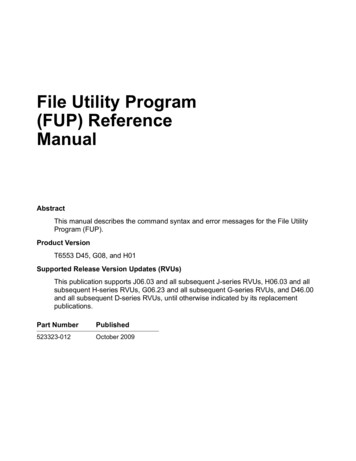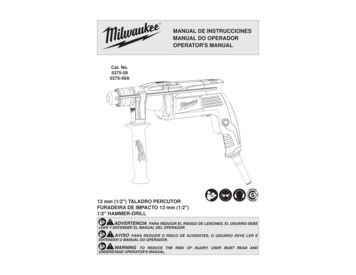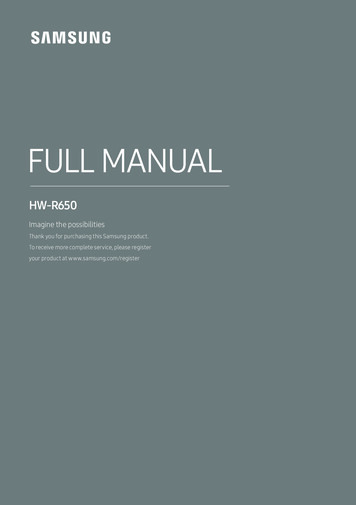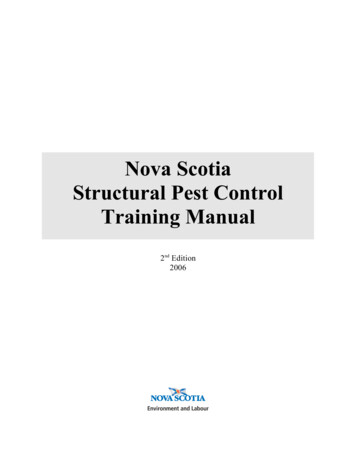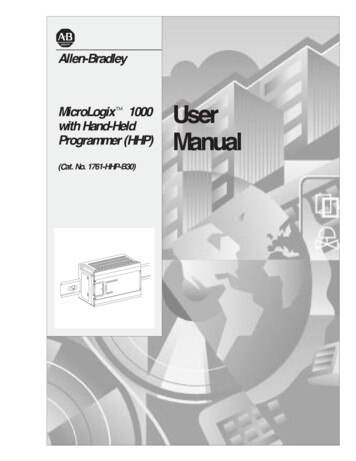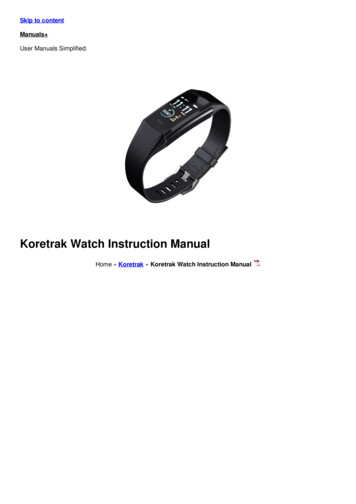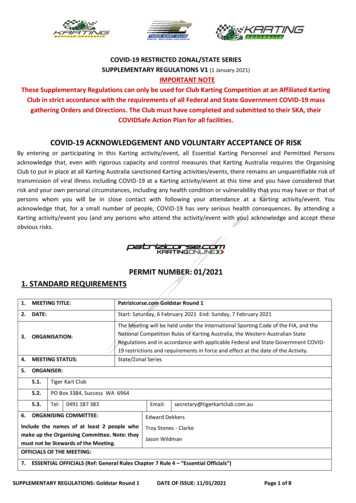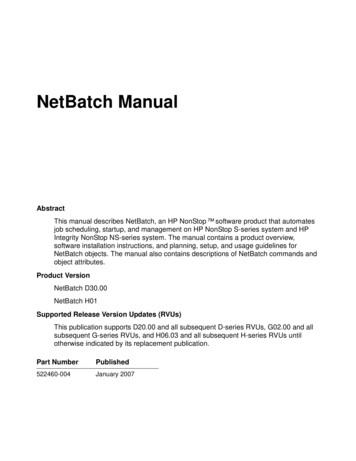
Transcription
NetBatch ManualAbstractThis manual describes NetBatch, an HP NonStop software product that automatesjob scheduling, startup, and management on HP NonStop S-series system and HPIntegrity NonStop NS-series system. The manual contains a product overview,software installation instructions, and planning, setup, and usage guidelines forNetBatch objects. The manual also contains descriptions of NetBatch commands andobject attributes.Product VersionNetBatch D30.00NetBatch H01Supported Release Version Updates (RVUs)This publication supports D20.00 and all subsequent D-series RVUs, G02.00 and allsubsequent G-series RVUs, and H06.03 and all subsequent H-series RVUs untilotherwise indicated by its replacement publication.Part NumberPublished522460-004January 2007
Document HistoryPart NumberProduct VersionPublished142530NetBatch D30August 1998522460-001NetBatch D30February 2002522460-002NetBatch D30May 2002522460-003NetBatch D30September 2005522460-004NetBatch D30, H01January 2007
NetBatch ManualGlossaryIndexFiguresWhat’s New in This Manual xiiiManual Information xiiiNew and Changed InformationAbout This Manual xviiAudience xviiOrganization xviiFurther Reading xixNotation ConventionsAbbreviations xxivTablesxiiixx1. NetBatch IntroductionProduct Overview 1-1NetBatch Jobs 1-1Executor Programs 1-2Network Capabilities 1-2CPU Assignment 1-2ASSIGNs, DEFINEs, and PARAMsOperator Interface 1-3Scheduling Options 1-3Scheduler Logging 1-3Programmatic Interfaces 1-3Spooler Jobs 1-3Core Components 1-4NETBATCH 1-4BATCHCOM 1-4BATCHCAL 1-4NBEXEC 1-4NB JOB SUBMIT 1-5Scheduler Functions 1-6CPU Assignment 1-6Job Storage 1-71-3Hewlett-Packard Company—522460-004i
1. NetBatch Introduction (continued)Contents1. NetBatch Introduction (continued)Job Scheduling and Startup 1-8Job Tracking, Control, and TerminationNetBatch High-PIN Capabilities 1-121-92. Software InstallationInstalling NetBatch Software—Overview 2-1NetBatch Product Files 2-1Installation Prerequisites 2-2Installation Procedure 2-3Step 1: Log On as the Super ID 2-3Step 2: Shut Down NETBATCH and Stop Its Processes 2-4Step 3: Receive NetBatch Product Files 2-4Step 4: Export and Print the NetBatch Softdoc 2-4Step 5: Perform Pre-installation Tasks 2-4Step 6: Perform Installation-Related Tasks 2-4Step 7: Perform Post-installation Tasks 2-5Step 8: Restart Schedulers 2-7Migrating a Scheduler Database 2-7Step 1: Log on as the Super ID (255,255). 2-7Step 2: Shut Down the Scheduler 2-7Step 3: Copy the Database Files to the Target Location 2-8Step 4: Secure the Migrated JOB File to Local Super ID 2-8Step 5: Update Alternate Key File References 2-9Step 6: Warm Start Scheduler 2-9Step 7: Verify and Alter Attributes 2-93. Scheduler Planning, Configuration, and ManagementPlanning Schedulers 3-1Task 1. Compile Job Information 3-1Task 2. Determine Scheduler Numbers and Attributes 3-2Task 3. Establish Class and Executor Configurations 3-6Starting Schedulers 3-9Overview 3-9Running NETBATCH 3-10Cold Starting a Scheduler 3-15Warm Starting a Scheduler 3-18Warm-Start Events 3-21Configuring Schedulers 3-23NetBatch Manual—522460-004ii
Contents3. Scheduler Planning, Configuration, andManagement (continued)3. Scheduler Planning, Configuration, andManagement (continued)Scheduler Configuration Commands 3-23Scheduler Configuration Procedure 3-23Displaying Scheduler Configuration 3-25Automating Scheduler Configuration 3-26Managing Schedulers 3-29Determining Whether a Scheduler Is Running 3-29Displaying Scheduler, Executor, and Class Status 3-29Altering Executor and Class Attributes 3-33Stopping and Restarting Executors 3-34Deleting Executors and Classes 3-35Dealing With Scheduler Log Files 3-38Enabling and Disabling EMS Event-Message GenerationStopping a Scheduler 3-453-444. Job Planning, Submission, and ManagementPlanning Jobs 4-1Planning Procedure 4-1Creating a Job Input File 4-7Using Completion Codes to Test Process Termination Status 4-7Identifying Processes of a Job 4-10ZBAT:JOBINFO 4-12Submitting Jobs 4-13Submitting a Job With the SUBMIT JOB Command 4-13Specifying a Job’s Class and Selection Priority 4-19Specifying a Job’s Executor Program and the Program’s Run Options andParameters 4-20Specifying a Job’s Input File, Defaults, and PURGE-IN-FILE Attribute 4-21Specifying a Job’s Output File, Maximum Print Lines or Maximum Print Pages, andLog File 4-22Scheduling a Job 4-23Specifying a Job’s Hold Characteristics 4-26Controlling a Job’s Behavior on Process Failure 4-28Specifying a Job’s Tape Drives Requirements 4-30Specifying a Job’s Dependencies 4-31Specifying a Job’s ASSIGNs, DEFINEs, and PARAMs 4-34Specifying a Job’s Description 4-40Managing Jobs 4-42NetBatch Manual—522460-004iii
4. Job Planning, Submission, andManagement (continued)Contents4. Job Planning, Submission, and Management (continued)Displaying Job Status 4-42Altering Job Attributes 4-44Overriding Job Dependencies, Timing Attributes, and Selection PrioritySuspending and Reactivating Job Processes 4-45Stopping and Deleting Jobs 4-46Dealing With Job Output 4-474-445. Run Calendar Generation and DisplayExample 5-1Running BATCHCAL 5-2BATCHCAL’s High PIN Capabilities 5-4Entering Source Data 5-5Entering Source Data in a File Versus Entering It Interactively 5-5Formatting Source Data 5-6Using BATCHCAL Commands 5-13 Command 5-13EXIT Command 5-13FC Command 5-13HELP Command 5-14Generating a Run Calendar 5-14Generating a Run Calendar From an EDIT Source File 5-14Generating a Run Calendar During an Interactive BATCHCAL SessionDisplaying Run Times 5-16Displaying Run Times in List Form 5-17Displaying Run Times in Chart Form 5-19Reformatting an Old Calendar File 5-226. CommandsRunning BATCHCOM 6-1Considerations 6-2BATCHCOM’s High PIN Capabilities 6-6Keywords 6-7Keyword Types 6-7Keyword Abbreviations 6-9Keyword and Command Aliases 6-11Command Reference Summary 6-11Command to Run NETBATCH 6-11Command to Run BATCHCOM 6-11NetBatch Manual—522460-004iv5-15
6. Commands (continued)Contents6. Commands (continued)Attachment-Set Commands 6-12Class Commands 6-13Executor Commands 6-14Job Commands 6-15Scheduler Commands 6-20Other Commands 6-22Command Security 6-23Command Descriptions 6-28Wild-Card Characters 6-29ABORT SCHEDULER Command 6-30ACTIVATE JOB Command 6-32ADD ATTACHMENT-SET Command 6-34ADD CLASS Command 6-40ADD EXECUTOR Command 6-42ADD SCHEDULER Command 6-46ALLOW ERRORS Command 6-51ALTER ATTACHMENT-SET Command 6-52ALTER CLASS Command 6-58ALTER EXECUTOR Command 6-59ALTER JOB Command 6-62ALTER SCHEDULER Command 6-67ASSUME ATTACHMENT-SET Command 6-69ASSUME CLASS Command 6-70ASSUME EXECUTOR Command 6-71ASSUME JOB Command 6-72ASSUME SCHEDULER Command 6-73CHANGEUSER Command 6-74COMMENT Command 6-76DELETE ATTACHMENT-SET Command 6-77DELETE CLASS Command 6-81DELETE EXECUTOR Command 6-82DELETE JOB Command 6-84DISPLAY-SPI Command 6-86EXIT Command 6-92FC Command 6-92HELP Command 6-95HISTORY Command 6-98INFO ATTACHMENT-SET Command 6-99NetBatch Manual—522460-004v
6. Commands (continued)Contents6. Commands (continued)INFO CLASS Command 6-103INFO EXECUTOR Command 6-104INFO JOB Command 6-106INFO SCHEDULER Command 6-110OBEY Command 6-112OPEN Command 6-113RELEASE-WAITON Command 6-115REPORT JOB Command 6-116RESET ATTACHMENT-SET Command 6-117RESET CLASS Command 6-119RESET EXECUTOR Command 6-120RESET JOB Command 6-121RESET SCHEDULER Command 6-122RUN Command 6-124RUNNEXT JOB Command 6-125RUNNOW JOB Command 6-128SET ATTACHMENT-SET Command 6-130SET CLASS Command 6-133SET EXECUTOR Command 6-134SET JOB Command 6-136SET SCHEDULER Command 6-140SHOW ATTACHMENT-SET Command 6-142SHOW CLASS Command 6-145SHOW EXECUTOR Command 6-146SHOW JOB Command 6-147SHOW SCHEDULER Command 6-150SHUTDOWN SCHEDULER Command 6-152START EXECUTOR Command 6-155START SCHEDULER Command 6-157STATUS ATTACHMENT-SET Command 6-160STATUS EXECUTOR Command 6-163STATUS JOB Command 6-165STATUS SCHEDULER Command 6-173STATUS-HISTORY Command 6-175STOP EXECUTOR Command 6-178STOP JOB Command 6-180SUBMIT JOB Command 6-183SUSPEND JOB Command 6-190NetBatch Manual—522460-004vi
6. Commands (continued)Contents6. Commands (continued)SWITCHCPU SCHEDULER CommandSWITCHLOG SCHEDULER CommandSYSTEM Command 6-195VOLUME Command 6-196! Command 6-198? Command 6-2006-1926-1937. AttributesAttribute Reference Summary 7-1Attachment-Set Attributes 7-1Class Attribute 7-1Executor Attributes 7-2Job Attributes 7-2Scheduler Attributes 7-6Attribute Descriptions 7-8AFTER Job Attribute 7-9ASSIGN Attachment-Set Attribute 7-12AT Job Attribute 7-15AT-ALLOWED Scheduler Attribute 7-18ATTACHMENT-SET Job Attribute 7-19BACKUPCPU Scheduler Attribute 7-23CALENDAR Job Attribute 7-25CATCHUP Scheduler Attribute 7-28CLASS Executor Attribute 7-30CLASS Job Attribute 7-32CPU Executor Attribute 7-34DEFAULT-CLASS Scheduler Attribute 7-36DEFAULT-EXECUTOR-PROGRAM Scheduler Attribute 7-38DEFAULT-HIGHPIN Scheduler Attribute 7-39DEFAULT-MAXPRINTLINES Scheduler Attribute 7-40DEFAULT-MAXPRINTPAGES Scheduler Attribute 7-41DEFAULT-OUT Scheduler Attribute 7-42DEFAULT-PRI Scheduler Attribute 7-43DEFAULT-SELPRI Scheduler Attribute 7-44DEFAULT-STALL Scheduler Attribute 7-45DEFAULT-STOP-ON-ABEND Scheduler Attribute 7-46DEFINE Attachment-Set Attribute 7-47DESCRIPTION Job Attribute 7-52NetBatch Manual—522460-004vii
7. Attributes (continued)Contents7. Attributes (continued)EMS Scheduler Attribute 7-54EVERY Job Attribute 7-55EXECUTOR-PROGRAM Job Attribute 7-58EXTSWAP Job Attribute 7-60HIGHPIN Job Attribute 7-61HOLD Job Attribute 7-62HOLDAFTER Job Attribute 7-63IFFAILS Job Attribute 7-64IN Job Attribute 7-66INITIATION Class Attribute 7-68INITIATION Scheduler Attribute 7-69JOB-LOG Job Attribute 7-70JOBID-ZERO Job Attribute 7-73LIB Job Attribute 7-74LIMIT Job Attribute 7-75LOCALNAMES Scheduler Attribute 7-77MAX-CONCURRENT-JOBS Scheduler AttributeMAX-PRI Scheduler Attribute 7-81MAXPRINTLINES Job Attribute 7-82MAXPRINTPAGES Job Attribute 7-83MEM Job Attribute 7-85NAME Job Attribute 7-86OUT Job Attribute 7-87PARAM Attachment-Set Attribute 7-89PFS Job Attribute 7-91PRI Job Attribute 7-92PURGE-IN-FILE Job Attribute 7-93RESTART Job Attribute 7-95RUND Job Attribute 7-97SAVEABEND Job Attribute 7-98SECURITY Attachment-Set Attribute 7-99SELPRI Job Attribute 7-101STALL Job Attribute 7-102STARTUP Job Attribute 7-104STOP-ON-ABEND Job Attribute 7-105SUBMIT-ALLOWED Scheduler Attribute 7-107SWAP Job Attribute 7-108TAPEDRIVES Job Attribute 7-109NetBatch Manual—522460-004viii7-79
7. Attributes (continued)Contents7. Attributes (continued)TAPEDRIVES Scheduler Attribute 7-110TEMPORARY Attachment-Set Attribute 7-112TERM Job Attribute 7-114VOLUME Job Attribute 7-116WAIT Job Attribute 7-118WAITON Job Attribute 7-119A. MessagesMessage Types A-2Error Messages A-2Informational Messages A-2Warning Messages A-2Message Descriptions A-3B. NBEXECIntroducing NBEXEC B-1TACL Alternative B-1Application Design Tool B-1Improved Resource Usage B-1Automatic Restart B-1Log Files B-2NBEXEC Processing B-2High PIN Capabilities B-2Command and Variable Reference Summary B-3Command Identifiers B-3NBEXEC-Defined Variables B-4NBEXEC Syntax Summary B-5Command to Run NBEXEC B-5Control-file ( ) Commands B-6Command-Interpreter (:) Commands B-7Other Commands B-10NBEXEC-Defined Logical Variables B-10NBEXEC-Defined String Variables B-10NetBatch Manual—522460-004ix
C. National Language SupportContentsC. National Language SupportChanging BATCHCOM Keywords and Messages C-1Step 1: Log On as the Super ID C-1Step 2: Make a Backup Copy of BATCHLIB C-1Step 3: Extract Keywords and Messages From BATCHLIB C-1Step 4: Change Keywords and Messages in EDIT Source File C-2Step 5: Convert EDIT Source File to TAL Source File C-6Step 6: Compile TAL Source File C-6Step 7: Bind Compiled Object Into BATCHLIB C-6Step 8: Assign Updated BATCHLIB File to BATCHCOM C-7Step 9: Add DEFINE ZBAT NLS to the TACL Environment C-7GlossaryIndexFiguresFigure 1-1.Figure 1-2.Figure 1-3.Figure 1-4.Figure 2-1.Figure 2-2.Figure 3-1.Figure 3-2.Figure 3-3.Figure 3-4.Figure 3-5.Figure 3-6.Figure 3-7.Figure 4-1.Figure 4-2.Figure 4-3.Figure 4-4.Figure 4-5.Figure 4-6.Figure 4-7.Figure 4-8.Figure 4-9.A NetBatch Job 1-2NetBatch Environment 1-5Sample Job, Class, Executor, and CPU Relationships 1-7Scheduling Algorithm 1-10NetBatch Software Installation Overview 2-3NBFLAGS Bit Settings 2-5Example of a Job Table for Scheduler Planning 3-2Example of a Scheduler Planning Table 3-5Example of a Class and Executor Planning Table 3-8Example of ALTER EXECUTOR Command 3-34Example of DELETE EXECUTOR Command 3-36Example of DELETE CLASS Command 3-37Example of a Scheduler Log File 3-38Sample Programs and Run Environments Diagram 4-3Sample Job Dependencies Diagram 4-4Sample Jobs Planning Table 4-6Sample Input File 4-7Sample #CASE and #IF Constructs for Completion Code Testing 4-9Sample Job Input File Containing #CASE Statements 4-9Example of GMOMJOBID Propagation 4-10Example of Dissociated Processes 4-11Decision Chart for Setting IFFAILS, RESTART, STALL, and STOP-ONABEND Attributes 4-29NetBatch Manual—522460-004x
Figures (continued)ContentsFigures (continued)Figure 4-10.Figure 4-11.Figure 4-12.Figure 4-13.Figure 6-1.Figure 6-2.Figure 6-3.Figure 6-4.Figure 6-5.Figure 6-6.Figure 6-7.Sample #IF Statements for ZBAT:RELEASE Error 4-33Sample Job Log File 4-48Example of Executor-Program Output 4-49Example of Nonexecutor-Program Output 4-49Examples of Attribute Defaulting-Attachment Set 6-36Example of Attribute Defaulting-Class 6-40Example of Attribute Defaulting-Executor 6-43Example of Attribute Defaulting-Scheduler 6-48Status JOB., DETAIL Command Display for Jobs That Are NotExecuting, Over Limit, or Suspended 6-168JOB., DETAIL C ommand- Display for Jobs That Are Not Executing,Over Limit, or Suspended 6-169Example of Attribute Defaulting-Job 6-186TablesTable 1-1.Table 1-2.Table 2-1.Table 2-2.Table 2-3.Table 3-1.Table 3-2.Table 3-3.Table 3-4.Table 4-1.Table 4-2.Table 4-3.Table 4-4.Table 4-5.Table 4-6.Table 4-7.Table 5-1.Table 5-2.Table 5-3.Table 5-4.Table 6-1.Table 6-2.Table 6-3.Scheduling Algorithm Description 1-11NetBatch D20 High PIN Capabilities 1-12NetBatch Subvolumes 2-1NetBatch Product Files 2-1NetBatch Installation Prerequisites 2-2Scheduler Attributes 3-4High PIN Capabilities in NETBATCH 3-14Scheduler Log File Keywords 3-41Scheduler Log File Logging Formats 3-43Sample Job Category Table 4-2Sample Job-Recovery Strategies 4-5Completion Codes 4-8Job Attributes 4-15Job States on Process Failure 4-28Attachment-Set Attributes 4-36Job State 4-42High PIN Capabilities in BATCHCAL 5-4Displaying Run Times in List Form 5-17Displaying Run Times in Chart Form 5-19Reformatting an Old Calendar File 5-22High PIN Capabilities in BATCHCOM 6-6Command Security 6-24Attachment-Set Defaults 6-35NetBatch Manual—522460-004xi
Tables (continued)ContentsTables (continued)Table 6-4.Table 6-5.Table 6-6.Table 6-7.Table 6-8.Table 6-9.Table 7-1.Table 7-2.Table 7-3.Executor Defaults 6-43Scheduler Defaults 6-47Files Created or Initialized by ADD SCHEDULER CommandExecutor States 6-164Job States 6-169Job Defaults 6-185DEFINE Types (Classes) 7-48DEFINE Attributes 7-48Attachment-Set Access 7-100NetBatch Manual—522460-004xii6-48
What’s New in This ManualManual InformationNetBatch ManualAbstractThis manual describes NetBatch, an HP NonStop software product that automatesjob scheduling, startup, and management on HP NonStop S-series system and HPIntegrity NonStop NS-series system. The manual contains a product overview,software installation instructions, and planning, setup, and usage guidelines forNetBatch objects. The manual also contains descriptions of NetBatch commands andobject attributes.Product VersionNetBatch D30.00NetBatch H01Supported Release Version Updates (RVUs)This publication supports D20.00 and all subsequent D-series RVUs, G02.00 and allsubsequent G-series RVUs, and H06.03 and all subsequent H-series RVUs untilotherwise indicated by its replacement publication.Part NumberPublished522460-004January 2007Document HistoryPart NumberProduct VersionPublished142530NetBatch D30August 1998522460-001NetBatch D30February 2002522460-002NetBatch D30May 2002522460-003NetBatch D30September 2005522460-004NetBatch D30, H01January 2007New and Changed InformationChanges to the G06.30 manual: Updated the range for the WAITON job attribute on pages 1-3, 4-18, 4-31, 7-5,7-119, and A-34.Added the description and examples for logging information greater than 132 bytesunder Interpreting the Contents of a Scheduler Log File on page 3-40NetBatch Manual—522460-004xiii
Changes to the G06.27 ManualWhat’s New in This Manual Changed the range of job numbers for systems running G-series RVUs on pages4-13, 6-187, A-23, and Glossary-5.Changed the consideration on DST explaining how next-runtime is calculated afterDST on page 6-188.Added the error message 2110-E on page A-25.Changes to the G06.27 Manual Updated the TACL RUN command with the REPORT and jobrun-databasesubvol attributes under Running NETBATCH on page 3-10.Added the description for: REPORT-ON on page 3-12jobrun-database-subvol on page 3-13Added the synopsis and syntax summary of the REPORT JOB under JobCommands on page 6-17.Added the new command, REPORT JOB, under Command Security 6-26.Added the description for REPORT JOB Command on page 6-116.Changes to the G06.16 Manual Updated Section 2, Software Installation, to discuss use of DSM/SCM instead ofInstall.Added a consideration regarding when the scheduler INITIATION attribute is OFFto RUNNOW JOB Command on page 6-128Updated the descriptions of the READY and RUNNOW job states in Table 6-8, JobStates, on page 6-169Added scheduler INITIATION attribute information to the considerations in SUBMITJOB Command on page 6-183Added the message text to warning 0548-W on page A-12Added message 0549-I on page A-12Changes to the G06.15 Manual Added new events in Section 3, Scheduler Planning, Configuration, andManagementChanged the use of the RUNNOW command in Section 7, AttributesChanged the scheduler behavior when a job with the EVERY attribute is held off inSection 7, AttributesNetBatch Manual—522460-004xiv
Changes to the G06.15 ManualWhat’s New in This Manual Changed the BATCHCAL defaultAdded a new error to Appendix A, MessagesNetBatch Manual—522460-004xv
Changes to the G06.15 ManualWhat’s New in This ManualNetBatch Manual—522460-004xvi
About This ManualThis manual describes NetBatch, an HP NonStop software product that automates jobscheduling, startup, and management on HP NonStop systems. The manual contains aproduct overview, software installation instructions, and planning, setup, and usageguidelines for NetBatch objects. The manual also contains descriptions of NetBatchcommands and object attributes.AudienceThe intended audience for this manual includes NetBatch users who do any of: Plan, generate, maintain, and control use of the NetBatch productDesign, write, and test jobsSchedule jobs, and set up and maintain job dependenciesSubmit jobs, and monitor and manage batch runsAudience prerequisites include: A good working knowledge of the HP NonStop operating system and basic systemoperationsPrevious exposure to batch processing softwareOrganizationSectionDescriptionSection 1, NetBatchIntroductionContains an overview of the NetBatch product, and lists anddescribes core NetBatch components. It also describes functionsof the NetBatch scheduler and explains the scheduling algorithm.Section 2, SoftwareInstallationExplains NetBatch software installation, and lists and describesNetBatch product files. It also describes how to migrate ascheduler database from one location to another.Section 3, SchedulerPlanning, Configuration,and ManagementDocuments a scheduler planning process and explains how tocold start, warm start, and configure schedulers. It also describeshow to perform scheduler-management tasks.Section 4, Job Planning,Submission, andManagementDocuments a job planning process and explains how to submit ajob to a scheduler. It also describes how to perform jobmanagement tasks.Section 5, Run CalendarGeneration and DisplayIntroduces BATCHCAL run calendars and explains their use injob scheduling. It also lists the procedures for generating runcalendars, displaying run times, and reformatting old calendarfiles to the current format.NetBatch Manual—522460-004xvii
OrganizationAbout This ManualSectionDescriptionSection 6, CommandsDescribes and gives examples of the syntax, operation, andresults of all BATCHCOM commands.Section 7, AttributesDescribes and gives examples of the syntax, operation, andresults of all attachment-set, class, executor, job, and schedulerattributes.Appendix A, MessagesLists NetBatch error, informational, and warning messages, andgives cause, effect, and recovery information for thosemessages.Appendix B, NBEXECPresents a management-level synopsis of NBEXEC, theNetBatch NonStop executor program. It also supplies a quickreference guide to NBEXEC command and variable syntax.Appendix C, NationalLanguage SupportExplains how to change BATCHCOM keywords and messagesto suit your operational environment.This chart indicates the intended audience for each section and appendix:For users who.Plan, generate,maintain, andcontrol theNetBatch systemDesign,write,and testjobsSchedule jobs,and set up andmaintain jobdependenciesSubmit jobs,and monitorand managebatch runsSection 1, NetBatchIntroductionXXXXSection 2, SoftwareInstallationXSection 3, SchedulerPlanning, Configuration,and ManagementXSection/AppendixXXSection 4, Job Planning,Submission, andManagementXXXSection 5, Run CalendarGeneration and DisplayXXXSection 6, CommandsXXXXSection 7, AttributesXXXXAppendix A, MessagesXXXXXAppendix B, NBEXECAppendix C, NationalLanguage SupportXNetBatch Manual—522460-004xviii
Further ReadingAbout This ManualFurther ReadingThis manual contains references to:ManualDescriptionDebug ManualDescribes the Guardian debug facility on TNS andTNS/R systemsDSM Template Services ManualDescribes Distributed Systems Management (DSM)Template Services, which support the representationof SPI buffers in display textDSM/SCM User’s GuideDescribes how to plan for and install a new softwarerelease or software product revision (SPR) usingDSM/SCM. It describes the overall installationprocess, the usage of DSM/SCM, and the specifictasks required to install system softwareEDIT User’s Guide and ReferenceManualDescribes the syntax of EDIT commands, explainshow to create and use EDIT files, and describesEDIT versus page-mode editingEMS ManualDescribes EMS, a collection of processes, tools, andinterfaces that provide event-message collection anddistribution in the DSM environmentFile Utility Program (FUP) ReferenceManualDescribes the syntax of all FUP commands andincludes explanations of FUP error messagesGuardian Procedure Calls ReferenceManualDescribes all system procedure callsGuardian Procedure Errors andMessages ManualDescribes system procedure error codes and errorlists, system messages, traps, and the trap error listGuardian Programmer’s GuideDescribes how to use the Guardian procedure callinterface to access system services from anapplication programGuardian User’s GuideDescribes basic operating-system tasksInspect ManualDescribes the Inspect interactive symbolic debuggerfor TNS/R and TNS/E systems. The manual isintended for system and application programmers.NetBatch ManagementProgramming ManualDescribes the Distributed Systems Management(DSM) programmatic interfaces (commands,responses, and event messages in SubsystemProgrammatic Interface (SPI) format) to theNetBatch subsystemNetBatch-Plus Reference ManualDescribes NetBatch-Plus, a Pathway application thatprovides a screen-driven NetBatch interfaceSafeguard Reference ManualDescribes the Safeguard distributed securitymanagement facility and the syntax of thecommands of the SAFECOM command interpreterNetBatch Manual—522460-004xix
Notation ConventionsAbout This ManualManualDescriptionSPI Programming ManualDescribes the Subsystem Programmatic Interfaceand tells how to use it in management applicationsand subsystems you writeSystem Generation ManualDescribes software installation and systemgenerationTACL Programming GuidePresents examples of HP Tandem AdvancedCommand Language (TACL) macros and routinesTACL Reference ManualDescribes the syntax, operation, and results of allTACL commands, functions, built-in functions, andbuilt-in variablesNotation ConventionsHypertext LinksBlue underline is used to indicate a hypertext link within text. By clicking a passage oftext with a blue underline, you are taken to the location described. For example:This requirement is described under Backup DAM Volumes and Physical DiskDrives on page 3-2.General Syntax NotationThis list summarizes the notation conventions for syntax presentation in this manual.UPPERCASE LETTERS. Uppercase letters indicate keywords and reserved words; enterthese items exactly as shown. Items not enclosed in brackets are required. Forexample:MAXATTACHlowercase italic letters. Lowercase italic letters indicate variable items that you supply.Items not enclosed in brackets are required. For example:file-namecomputer type. Computer type letters within text indicate C and Open System Services(OSS) keywords and reserved words; enter these items exactly as shown. Items notenclosed in brackets are required. For example:myfile.citalic computer type. Italic computer type letters within text indicate C and OpenSystem Services (OSS) variable items that you supply. Items not enclosed in bracketsare required. For example:pathnameNetBatch Manual—522460-004xx
General Syntax NotationAbout This Manual[ ] Brackets. Brackets enclose optional syntax items. For example:TERM [\system-name.] terminal-nameINT[ERRUPTS]A group of items enclosed in brackets is a list from which you can choose one item ornone. The items in the list may be arranged either vertically, with aligned brackets oneach side of the list, or horizontally, enclosed in a pair of brackets and separated byvertical lines. For example:FC [ num ][ -num ][ text ]K [ X D ] address{ } Braces. A group of items enclosed in braces is a list from which you are required tochoose one item. The items in the list may be arranged either vertically, with alignedbraces on each side of the list, or horizontally, enclosed in a pair of braces andseparated by vertical lines. For example:LISTOPENS PROCESS { appl-mgr-name }{ process-name }ALLOWSU { ON OFF } Vertical Line. A vertical line separates alternatives in a horizontal list that is enclosed inbrackets or braces. For example:INSPECT { OFF ON SAVEABEND } Ellipsis. An ellipsis immediately following a pair of brackets or braces indicates that youcan repeat the enclosed sequence of syntax items any number of times. For example:M address [ , new-value ] [ - ] {0 1 2 3 4 5 6 7 8 9} An ellipsis immediately following a single syntax item indicates that you can repeat thatsyntax item any number of times. For example:"s-char "Punctuation. Parentheses, commas, semicolons, and other symbols not previouslydescribed must be entered as shown. For example:error : NEXTFILENAME ( file-name ) ;LISTOPENS SU process-name.#su-nameQuotation marks around a symbol such as a bracket or brace indicate the symbol is arequired character that you must enter as shown. For example:"[" repetition-constant-list "]"NetBatch Manual—522460-004xxi
Notation for MessagesAbout This ManualItem Spacing. Spaces shown between items are required unless one of the items is apunctuation symbol such as a parenthesis or a comma. For example:CALL STEPMOM ( process-id ) ;If there is no space between two items, spaces are not permitted. In these examples,there are no spaces permitted between the period and any other items: process-name.#su-nameLine Spacing. If the syntax of a command is too long to fit on a single line, eachcontinuation line is indented three spaces and is separated from the preceding line bya blank line. This spacing distinguishes items in a continuation line from items in avertical list of selections. For example:ALTER [ / OUT file-spec / ] LINE[ , attribute-spec ] !i and !o. In procedure calls, the !i notation follows an input parameter (one that passes datato the called procedure); the !o notation follows an output parameter (one that returnsdata to the calling program). For example:CALL CHECKRESIZESEGMENT (segment-id, error) ;!i!o!i,o. In procedure calls, the !i,o notation follows an input/output parameter (one that bothpasses data to the called procedure and returns data to the calling program). Forexample:error : COMPRESSEDIT ( filenum ) ;!i:i.!i,oIn procedure calls, the !i:i notation follows an input string parameter that has acorresponding parameter specifying the length of the string in bytes. For example:error : FILENAME COMPARE (filename1:length, filename2:length ) ;!i:i!i:i!o:i. In procedure calls, the !o:i notation follows an output buffer parameter that has acorresponding input parameter specifying the maximum length of the output buffer inbytes. For example:error : FILE GETINFO (filenum, [ filename:maxlen ] ) ;!i!o:iNotation for Messageslist summarizes the notation conventions for the presentation of displayed messagesin this manual.NetBatch Manual—522460-004xxii
Notation for MessagesAbout This ManualBold Text. Bold text in an example indicates user input entered at the terminal. Forexample:ENTER RUN CODE?123CODE RECEIVED:123.00The user must press the Return key after typing the input.Nonitalic text. Nonitalic letters, numbers, and punctuation indicate text that is displayed orreturned exactly as shown. For example:Backup Up.lowercase italic letters. Lowercase italic letters indicate variable items whose values aredisplayed or returned. For example:p-registerprocess-name[ ] Brackets. Brackets enclose items that are sometimes, but not always, displayed. Forexample:Event number number [ Subject first-subject-value ]A group of items enclosed in brackets is a list of all possible items that can bedisplay
3. Scheduler Planning, Configuration, and Management (continued) Scheduler Configuration Commands 3-23 Scheduler Configuration Procedure 3-23 Displaying Scheduler Configuration 3-25 Automating Scheduler Configuration 3-26 Managing Schedulers 3-29 Determining Whether a Scheduler Is Running 3-29 Displaying Scheduler, Executor, and Class Status 3-29
